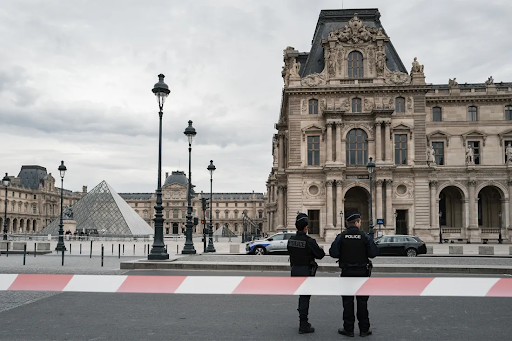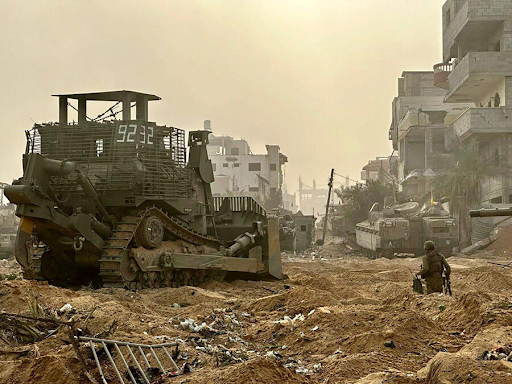Homegrown Terrorism and the American Condition
How many more children must be martyrs before something changes?
March 9, 2018
I was born in March of 2002, several months after the tragedy of September 11. Since then, there’s been some form of tragedy every year in the news. I am no longer overwhelmingly outraged by bombings in Syria, bloodshed in Afghanistan, political corruption in our own country, or the rise of homegrown terrorism. I have become especially familiar with massacres and mass shootings. According to The Guardian, since January 1, 2013, there have been 1,624 mass shootings in America, at least up until February 15, 2018. A majority of these shootings have involved a U.S. citizen as one of the attackers.
This sudden rise in terrorism by a state’s own citizens has been given a name: domestic terrorism. Domestic terrorism, also known as homegrown terrorism, has become a sudden plague upon not just the nation, but the entire world as well. However, mass shootings have become a critical part of the lives of everyday Americans; almost every day features another shooting. Most don’t make headlines.
The shootings that do reach national attention are ugly things that scar the reputation of a nation already struggling for respect among its own people. I no longer flinch when I read a new headline stating 12 have been shot; in fact, I have found myself considering that a small amount of people. Domestic terrorism has become a normal part of the American way of life. What makes matters more pressing, more heartbreaking, and more troubling about this homegrown terrorism, though, is that schools are regular targets of this violence and domestic terrorism.
In 2015, BBC reports that there were 64 school shootings in America, including when guns were shot but nobody was hurt. This means that a gun was fired on 64 different school campuses, in 64 different locations, in 64 different settings, and at 64 different times. Sixty-four times the lives of children were on the line, and 64 times a child was killed or could have been murdered.
As the Parkland, Florida, shooting gains more and more traction and inevitably disappears from the national spotlight, American students have decided this shooting is the last straw. Walkouts on anniversaries of shootings, student protests, city-wide protests, and slogans that vent students’ frustration and terror are common topics of conversation among us. “NEVER AGAIN” is written on our arms, “SAY SOMETHING” is painted on our art, and allusions to previous protests (“hands up,” from the Black Lives Matter protests) are drawn hastily on our faces as we cry for change. I have seen middle school students talk eagerly with juniors about what they’re going to do on the dates of walkouts, or discuss the March For Life campaign meant to fight for gun regulation laws. The students at Horizon Honors have been so outspoken about their own desire for change that the school is hosting a session designed to alleviate our frustrations, hosted on March 14, the one-month anniversary of the Parkland shooting.
Despite all this frustration, despite the anger, despite the terror, these forms of protest will ultimately do nothing to stop shootings or domestic terrorism. Only some form of legislation or legal change can do that. However, this legislation will never come to light if gun regulation is considered a “side of the coin” issue that, depending on political party, has only one obvious solution.
I am not here to say what I think about these forms of prevention offered by presidents, citizens, or anyone else. I am not here to say teachers should or should not be armed, or that all guns should be banned. That’s not the point anymore, really. The question of “what next?” cannot be solved until the concept of the death of children is no longer a bipartisan issue.
As of the time of writing, Florida has released some forms of gun regulation, according to BBC. The state Senate passed the bill with a 20-18 vote. The legislation, as NPR states, changes the buying age to 21, bans the sale and purchase of bump stocks (additions to guns that imitate automatic weapons), and sets up a three-day waiting period before buying any gun. This legislation also provides $400 million for mental health services. There is also “opt-in” legislation where some teachers may be armed with a gun. The state House of Representatives must vote on it, and the governor must approve of it as well before it can be a legitimate law.
These are all steps attempting to reconcile the lives lost with our Second Amendment rights. The Amendment written in 1791 says, “A well regulated Militia, being necessary to the security of the free State, the right of the people to keep and bear Arms, shall not be infringed.” Although this Amendment was designed to allow a revolution against the government if ever the need arose, the evolution of military weaponry and the access that citizens have to the same weaponry of the United States military has drifted wildly from an era where the most lethal weapons could only hold 22 bullets, as The Washington Post details. At this time, citizens could also legally own their own cannons, their own rifles with calibers over .70mm (any bullet larger than .50mm is now banned in the U.S. as a weapon of destruction), and the price of firearms that didn’t have to be reloaded after every shot were so ridiculously expensive that not even whole armies could be armed with them. Those reloading guns also could take up to two minutes between bullets, The Washington Post says. There are also more guns today than there were in the 18th century.
Let’s not forget about how dramatic the difference between militia weaponry and civilian weaponry is today, too. The United States has a multitude of nuclear weapons. They have tanks. They have land mines. If the people were to ever start an uprising with the current weaponry accessible by the citizens, the army could wipe us out. As that being one of the reasons against gun control, even just the weapons available now would not win against our government.
Granted, the existence of powerful weapons in civilian households could, in a revolution, help us gain the upper hand. Still, Americans would not win. National Priority states that, as of 2015, military spending was 54 percent of America’s discretionary spending (money spent through legislative bills). That is over half of a trillion dollars. The American military is much more massive, with much more funding, than all of America’s citizens could replicate into one unit of comparable size and organization.
In the eyes of most Republicans, the Second Amendment is being infringed upon by gun control. I have also heard of Democrats declaring that banning almost all guns, except under very special circumstances, from the public domain would cure the problem. This is an extremity as well.
This distrust of the other party and extreme regulation or lack thereof has culminated in a debate among civilians over what we should do. Must something change? What should we do, if so? How will it change schools? How will it change public life? How do we balance a need for safety with a right to bear arms?
There are only two accepted answers. More guns or no guns. And that isn’t going to get anyone anywhere.
The death of children should not be a bipartisan issue. There is not one clear solution to the culture of guns and violence in America. This country is too diverse for two parties to hold two answers that will lead to either a good or bad solution.
What legislatures, students, adults, politicians, and every other person in America needs to do to make sure that another child or teacher doesn’t die at the hands of a gun in their place of education is to come together, political party lines aside, and find something to do to change this. I don’t care if the agreement of those parties means more weapons, as long as there’s a ton more background checks. I don’t care if there’s more laws that people will have to break, I don’t care if there’s less, I don’t care if the extremists on either side are upset. I don’t care if the compromise is “unfair.” As I said before, I am not here to discuss my stance on gun control and the possible ways to reduce the deaths of students.
All I want from America is for something to change, and constantly battling with two “clear” sides will do nothing. I never want to hear my little sister tell me that, if there was a school shooter, that I shouldn’t watch out for her. I don’t like knowing that children are buying bulletproof backpacks, according to ABC News. I don’t want another Vegas shooting, or Parkland shooting, or Columbine shooting, or Sandy Hook shooting, or any other of the thousands upon thousands of shootings and deaths that have come from this lack of change.
But, I don’t want to watch my grandmother, who served on the police force for 16 years, to give up the gun that gives her peace of mind. I don’t want my great-grandfather’s World War II gun to lose its position as a family heirloom. I don’t want to know that families can no longer hunt, even within reason, as hunting is a regular part of many people’s lives. I don’t want safe gun carriers to no longer have that sense of protection, since guns are effective weapons of defense.
I just want a compromise. There is no clear-cut solution, and it’s not happening when two parties scream at one another about how wrong the other side is.
All I want is change. All we, as a nation, need to do such a thing, is to put aside arbitrary lines and listen to the cries of mercy from terrified teenagers.








